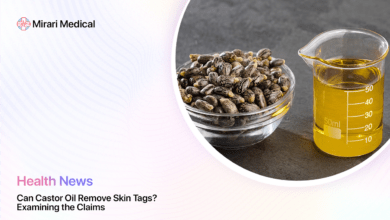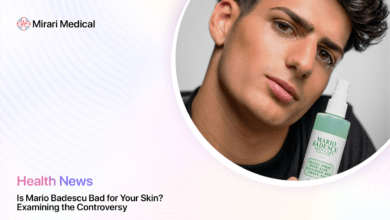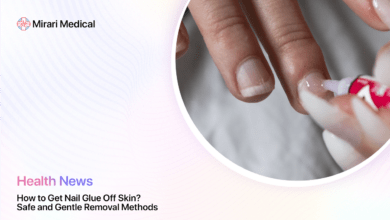Does Stainless Steel Turn Skin Green? Mystery Solved!

You may be interested
Ever noticed a greenish tinge on your skin after wearing stainless steel jewelry? You’re not alone! This guide unravels the science behind this surprising phenomenon and equips you with knowledge to prevent it.
Understanding Stainless Steel Skin Discoloration
Can all stainless steel turn skin green? The answer lies in the metal’s composition, particularly its nickel content. Stainless steel is an alloy made primarily of iron and chromium, with varying amounts of other elements like nickel, molybdenum, and carbon . The chromium forms a protective oxide layer on the surface, making the metal resistant to corrosion and rust . However, the presence of nickel can sometimes cause a reaction with your skin, leading to the infamous green discoloration.
The green stain is caused by a chemical reaction between the nickel in the stainless steel and the acids in your sweat . When you perspire, the sweat dissolves trace amounts of nickel from the metal, which then oxidizes and forms nickel salts . These green-tinted salts are absorbed by your skin, causing the discoloration. The reaction is more likely to occur if you have particularly acidic sweat or if you wear the jewelry for extended periods without allowing your skin to breathe .
Certain individuals may be more susceptible to this reaction, particularly those with sensitive skin or a nickel allergy . If you have a history of reacting to certain metals or have experienced skin irritation from jewelry in the past, you may be more prone to developing the green discoloration from stainless steel. In some cases, the reaction can even cause itching, redness, or a rash, indicating a more severe allergy .
Don’t Panic! Addressing the Green Stain
If you do notice a green mark on your skin after wearing stainless steel jewelry, don’t worry – in most cases, it’s temporary and harmless. The discoloration is simply a surface-level stain that can be easily washed off with soap and water . To remove the green tint, follow these simple steps:
- Remove the stainless steel jewelry and set it aside.
- Wash the affected area with warm water and a gentle soap or cleanser.
- Use a soft cloth or sponge to gently scrub the stain, using circular motions.
- Rinse the area thoroughly with clean water and pat dry with a towel.
- Apply a moisturizer to soothe the skin and prevent dryness.
In most cases, this simple cleaning routine will effectively remove the green stain from your skin. However, if the discoloration persists or is accompanied by itching, redness, or other signs of irritation, it’s best to consult a dermatologist to rule out a more serious metal allergy .
Preventing the Green from Returning: Stainless Steel Savvy
To minimize the risk of developing green skin from your stainless steel jewelry, there are several proactive steps you can take:
Choosing High-Quality Stainless Steel
One of the most effective ways to prevent skin discoloration is to invest in high-quality stainless steel jewelry. Look for pieces made from surgical-grade stainless steel, such as 316L, which contains a lower percentage of nickel compared to other grades . This type of stainless steel is less likely to cause a reaction, even for those with sensitive skin. It’s also more resistant to corrosion and tarnishing, ensuring that your jewelry maintains its shine and durability over time .
When shopping for stainless steel jewelry, be cautious of cheaper, low-quality pieces that may not disclose their exact metal composition. These items may contain higher levels of nickel or other allergens that can increase your risk of developing skin discoloration or irritation . Stick with reputable brands and retailers, and don’t be afraid to ask questions about the materials used in the jewelry.
Keeping Your Jewelry Clean
Regular cleaning and maintenance of your stainless steel jewelry can also help prevent the green skin reaction. Over time, dirt, sweat, and other debris can accumulate on the surface of the metal, increasing the likelihood of nickel leaching onto your skin . To keep your jewelry clean and minimize this risk, follow these tips:
- Clean your stainless steel jewelry regularly with a soft cloth and mild soap.
- Avoid exposing your jewelry to harsh chemicals, such as bleach or chlorine.
- Remove your jewelry before swimming, exercising, or engaging in other activities that cause you to sweat excessively.
- Store your jewelry in a cool, dry place when not in use, preferably in a sealed container or pouch.
By keeping your stainless steel jewelry clean and well-maintained, you can help extend its lifespan and reduce the chances of it reacting with your skin.
Applying a Clear Coat
For extra protection against skin discoloration, you can apply a clear coat to your stainless steel jewelry. This thin, transparent layer acts as a barrier between the metal and your skin, preventing direct contact and minimizing the risk of nickel leaching . There are several types of clear coats available, including:
- Clear nail polish: A simple and affordable option, clear nail polish can be easily applied to your jewelry and touched up as needed. However, it may wear off quickly and require frequent reapplication.
- Jewelry sealers: Specialized products designed specifically for sealing jewelry, these clear coats often provide longer-lasting protection and may be more durable than nail polish.
- Professional coatings: Some jewelers offer professional clear coating services that use advanced techniques and materials to create a more permanent barrier on your stainless steel jewelry.
When applying a clear coat, be sure to follow the manufacturer’s instructions carefully and allow the coating to dry completely before wearing the jewelry. Keep in mind that even with a clear coat, it’s still important to clean your jewelry regularly and remove it if you notice any signs of skin irritation.
Safe Alternatives for Sensitive Skin
If you have particularly sensitive skin or a known nickel allergy, you may want to consider alternative jewelry materials that are less likely to cause a reaction. Some safe options include:
Nickel-Free and Hypoallergenic Jewelry
Look for jewelry made from metals that are naturally nickel-free or hypoallergenic, such as:
- Surgical stainless steel (316L): As mentioned earlier, this grade of stainless steel contains a lower percentage of nickel and is less likely to cause skin irritation .
- Titanium: A lightweight, durable metal that is naturally hypoallergenic and resistant to corrosion .
- Niobium: Another hypoallergenic metal that is often used in medical implants and high-end jewelry .
- Sterling silver: A precious metal alloy that is 92.5% silver and 7.5% other metals, usually copper. Sterling silver is generally safe for sensitive skin, but some individuals may still react to the copper content .
When shopping for hypoallergenic jewelry, look for pieces that are clearly labeled as nickel-free or suitable for sensitive skin. Be aware that even these metals may cause a reaction in some individuals, so it’s always best to test a small piece of jewelry on a small area of skin before committing to wearing it regularly.
Considering Other Materials Altogether
If you find that you react to most metals, even those marketed as hypoallergenic, you may want to explore alternative materials for your jewelry. Some options to consider include:
- Natural materials: Wood, bone, shell, and stone jewelry can be beautiful and unique alternatives to metal. These materials are often naturally hypoallergenic and less likely to cause skin irritation .
- Plastic and resin: Lightweight and affordable, plastic and resin jewelry comes in a wide range of colors and styles. While not as durable as metal, these materials are generally safe for sensitive skin .
- Fabric and thread: Woven, knotted, or embroidered jewelry made from cotton, silk, or other natural fibers can be a comfortable and stylish option for those with metal sensitivities .
Remember, the key is to listen to your skin and pay attention to any signs of irritation or discomfort. If you notice a reaction to a particular material, discontinue use and consult a dermatologist if necessary.
Beyond Stainless Steel: Understanding Metal Allergies
While stainless steel is a common culprit for skin discoloration and irritation, it’s not the only metal that can cause problems for sensitive individuals. Other metals, such as nickel, cobalt, and chromium, can also trigger allergic reactions in some people . If you suspect that you may have a metal allergy, it’s important to know the signs and take steps to protect your skin.
Recognizing the Signs of a Nickel Allergy
A nickel allergy is a common type of metal allergy that can cause a range of symptoms when the skin comes into contact with nickel-containing objects, such as jewelry, buttons, or zippers. Some signs that you may have a nickel allergy include :
- Itching, redness, or swelling at the site of contact
- A rash or bumps that may spread beyond the initial contact area
- Dry, scaly patches of skin that resemble eczema
- Blisters or weeping sores in severe cases
If you suspect that you have a nickel allergy, it’s important to take steps to protect your skin and prevent further irritation. Here are some tips:
- Avoid contact with nickel-containing objects as much as possible. Look for jewelry and accessories labeled as “nickel-free” or “hypoallergenic.”
- If you must wear items that contain nickel, create a barrier between the metal and your skin using clear nail polish, a patch, or a protective coating.
- Wash your skin thoroughly with soap and water after any potential exposure to nickel.
- Apply a moisturizer or barrier cream to help protect your skin and soothe any irritation.
- Consider getting a patch test from a dermatologist to confirm your nickel allergy and identify any other potential metal sensitivities.
“Quote: “If you suspect a nickel allergy, consult a dermatologist for proper diagnosis and guidance on safe jewelry choices.”
Remember, while nickel allergies are common, other metals like cobalt and chromium can also cause skin reactions in some individuals . If you experience persistent or severe symptoms, it’s always best to seek medical advice to rule out other underlying conditions and develop a personalized management plan.
Caring for Your Stainless Steel Jewelry for Long-Lasting Shine
To keep your stainless steel jewelry looking its best and minimize the risk of skin reactions, it’s important to practice proper care and maintenance. Here are some tips for ensuring your pieces retain their luster and remain safe for your skin:
Proper Storage Techniques
When you’re not wearing your stainless steel jewelry, it’s crucial to store it properly to prevent damage, tarnishing, and the accumulation of dirt and debris. Follow these guidelines for optimal storage:
- Keep your jewelry in a cool, dry place away from direct sunlight and heat sources, which can cause discoloration and warping.
- Store each piece separately in a soft, lint-free pouch or a compartmentalized jewelry box to avoid scratches and tangling.
- Avoid storing your stainless steel jewelry in humid environments like bathrooms, as moisture can promote tarnishing and corrosion.
- If you’re storing your jewelry for an extended period, consider placing a small packet of silica gel or a tarnish-prevention strip in the container to absorb excess moisture.
Avoiding Harsh Chemicals
Exposure to certain chemicals can damage your stainless steel jewelry and increase the likelihood of skin reactions. To keep your pieces in top condition, avoid the following:
- Chlorine and bleach: These harsh chemicals can cause discoloration, pitting, and corrosion on the surface of your stainless steel jewelry. Remove your pieces before swimming in chlorinated pools or using cleaning products containing bleach.
- Perfumes and cosmetics: The chemicals in perfumes, lotions, and makeup can interact with the metal and lead to tarnishing or skin irritation. Apply these products before putting on your jewelry, and give them time to fully absorb into your skin.
- Acidic substances: Exposure to acidic foods, drinks, or household products can erode the protective layer on your stainless steel jewelry, making it more susceptible to damage and nickel leaching. Remove your jewelry when handling these items, and clean your pieces promptly if they come into contact with any acidic substances.
By being mindful of these common chemical culprits and taking steps to minimize exposure, you can help extend the life of your stainless steel jewelry and reduce the risk of skin reactions.
FAQs
Can cheap stainless steel jewelry turn my skin green more easily?
Yes, cheaper, low-quality stainless steel jewelry is more likely to contain higher levels of nickel and other alloys that can react with your skin and cause green discoloration. Investing in high-quality, nickel-free pieces can help minimize the risk of skin reactions.
How can I tell if my stainless steel jewelry is high quality?
Look for stainless steel jewelry that is labeled as “316L” or “surgical grade,” as these varieties contain lower levels of nickel and are less likely to cause skin irritation. Additionally, reputable brands and retailers should provide clear information about the metal composition and quality of their pieces.
What if I still experience skin irritation even with high-quality stainless steel?
If you have particularly sensitive skin or a severe nickel allergy, you may still experience irritation even with high-quality stainless steel jewelry. In these cases, it’s best to opt for alternative materials like titanium, niobium, or plastic, or consult with a dermatologist for personalized recommendations.
Are there any health risks associated with the green discoloration?
In most cases, the green discoloration caused by stainless steel jewelry is harmless and temporary. However, if the reaction is accompanied by severe itching, redness, blistering, or other signs of allergic contact dermatitis, it’s important to remove the jewelry and seek medical attention.
Can I wear stainless steel if I have other metal allergies?
If you have a known allergy to nickel, cobalt, or other metals, it’s best to exercise caution when wearing stainless steel jewelry. While high-quality, nickel-free stainless steel is generally considered hypoallergenic, there is still a risk of cross-reactivity with other metal sensitivities. Consulting with a dermatologist can help you determine the safest options for your individual needs.
Key Takeaways
- Stainless steel jewelry can turn skin green due to a reaction between the metal’s nickel content and acidic sweat.
- The green discoloration is usually temporary and can be removed with simple cleaning methods.
- To prevent green stains, choose high-quality, nickel-free stainless steel jewelry and keep it clean and dry.
- Those with sensitive skin or nickel allergies may prefer alternative materials like titanium or niobium.
- Proper storage and avoiding harsh chemicals can help maintain the quality of your stainless steel jewelry.
- If you experience severe or persistent skin reactions, consult a dermatologist for guidance on safe jewelry choices.
By understanding the science behind stainless steel and skin reactions, you can make informed decisions about your jewelry choices and enjoy wearing your favorite pieces with confidence. Remember, a little knowledge and care go a long way in maintaining both the beauty of your jewelry and the health of your skin!
Your trusted source for health info, offering expert advice, news, and tips to stay healthy and informed.





